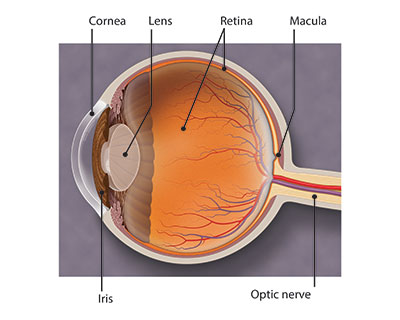Drusen are yellow deposits under the retina. Drusen are made up of lipids and proteins. Drusen can be different sizes—small, medium, and large. Small drusen are common in those 50 and older without age-related macular degeneration (AMD). But having many small drusen and larger drusen are often signs of AMD.
There are other drusen found in the optic nerve, which usually do not affect vision.
What Causes Drusen?
Drusen occur naturally with age. The exact relationship between degenerative macular disease and drusen is not clear. However, having large drusen is a sign of AMD.
Drusen of the Optic Nerve
Drusen can also occur in the optic nerve. These drusen are made up of protein and calcium salts and generally appear in both eyes. Unlike the drusen associated with AMD, optic nerve drusen (also known as optic disc drusen) are not related to aging, may be inherited, and typically appear in children. Optic nerve drusen usually do not affect vision, but some patients with these drusen may lose peripheral (side) vision.

Drusen Symptoms
Most people with drusen do not have any symptoms. Often, a routine eye exam will incidentally reveal their presence. A few small drusen are not a symptom of eye disease. However, the presence of a large number of larger drusen is an early sign of dry age-related macular degeneration (AMD). The symptoms of AMD include hazy vision, difficulty seeing when going from bright light to low light, and a blank or blurry spot in your central vision.
Optic nerve drusen also often do not produce symptoms. However, some patients with optic nerve drusen experience vision problems, including loss of peripheral (side) vision and temporary flickering or graying out of their vision.
Who Is at Risk for Drusen?
Drusen are typically a result of aging and are commonly found in people age 50 and older. Caucasians (white people) are more likely to develop drusen, as well as age-related macular degeneration (AMD). Large drusen are associated with AMD. Risk factors for AMD include:
- smoking
- obesity
- a family history of the disease
- high blood pressure, and
- high cholesterol (fat in your bloodstream)
The risk of developing optic nerve drusen is also higher for Caucasians and those with a family history of drusen.
Diagnosis
Drusen are detected during a dilated eye exam. To check your eyes, your ophthalmologist will dilate (widen) your pupils using dilating eyedrops and examine your eyes with an ophthalmoscope, a device that allows him or her to see the retina and other areas at the back of the eye. This examination will allow him or her to see if drusen are present.
If your ophthalmologist detects large drusen, they may have you use an Amsler grid to check for macular degeneration symptoms such as wavy, blurry or dark areas in your vision. If your ophthalmologist thinks you have optic nerve drusen, they may order additional imaging tests to confirm the diagnosis.
Drusen Treatment
Small drusen do not need to be treated. If your ophthalmologist finds small drusen during a routine eye exam, they may want to watch them regularly to make sure they do not become larger drusen.
Because larger drusen are a sign of age-related macular degeneration (AMD), your ophthalmologist will follow the AMD treatment appropriate for you. Trying to eliminate the drusen will not improve your AMD.
If you have optic nerve drusen without symptoms, you should be monitored regularly. There is no treatment for optic nerve drusen. In rare cases where choroidal neovascular membranes (new blood vessels growing under the retina) develop, treatment may be appropriate.